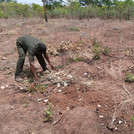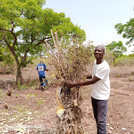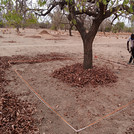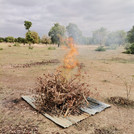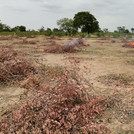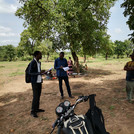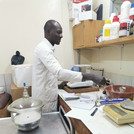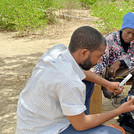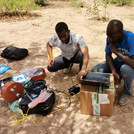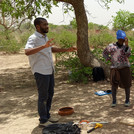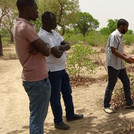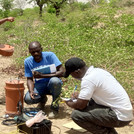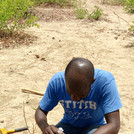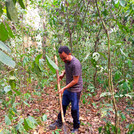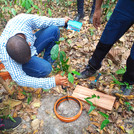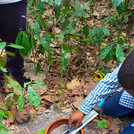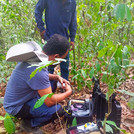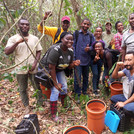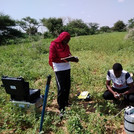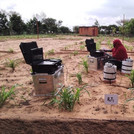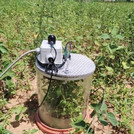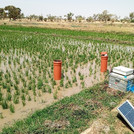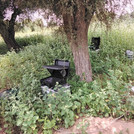Assess GHG emissions related to agricultural practices
This WP aims at quantifying GHG emissions caused by two major agricultural practices, i.e. biomass burning and fertilization. WP 5 addresses the following tasks:
- Assessing GHG emissions from biomass burning: The burning of crop residues and other biomass sources is a practice commonly used by farmers to prepare fields before the rainy season. For this task, we will randomly select ten fields for the two main crop species per site, and collect aboveground herbaceous biomass on ten 1 x 1 m plots per field at the end of the rainy season. Biomass samples will be oven-dried (70° C, 48 h) and weighed to quantify fuel load per area, and potential CO2 release. Subsequently, we will experimentally burn the biomass samples. Samples of air derived from biomass burning will be captured to measure the concentrations of GHGes by using colorimetric gas detector tubes (Hassouna et Eglin, 2015).
- In-situ measurements of GHG emissions related to synthetic fertilizers and manure: For this task, we will compare three types of fields, i.e. (i) fields fertilized with synthetic fertilizers; (ii) fields fertilized with manure, and (iii) unfertilized controls. As we aim at assessing the GHG emission signature under realistic levels of fertilization, we will not set up standardized field experiments (as commonly done in previous studies measuring GHG emissions), but rather choose fields established at least five years ago (i.e. in the “Cropland Remaining Cropland” case) with comparable topo-edaphic conditions that mainly differ in fertilizer application (ten fields per site and treatment type). Information on the quantity of fertilizers and manure used by each farmer will be noted as well as the soil management system applied.
- In West Africa, the application of fertilizers (NPK and Urea) and manure is generally made by hand, suggesting that fertilizer distribution is not homogeneous at the field scale. Therefore, gas samples will be taken in three positions of each individual field. We will thus sample at 540 locations (6 sites x 3 treatments x 10 fields x 3 replicates). Samples of gas emitted from the soil surface will be taken with in situ custom-made vented static gas flux chambers constructed according to the GRACEnet protocol (Hutchinson and Mosier, 1981; Hutchinson and Livingston, 1993 In: Smith et al 2012).
- Base rings will be placed in the ground directly after fertilization; they will remain in the field until after harvest. Flux chambers will be installed in each treatment type. Gas chromatography (Shimadzu GC-2014, Columbia, Maryland) will be used to determine the concentrations of greenhouse gases in air samples, including methane (CH4), carbon dioxide (CO2) and nitrous oxide (N2O). Gas samples will be taken at 0, 15, 30 and 45 min intervals following chamber closure. This will allow a gas flux rate to be calculated from the change in concentration for the 45 min interval. Gas flux measurements will be taken at approximately the same time each day. At each time interval, gas samples (10 ml) will be collected with polypropylene syringes and injected into evacuated glass vials (6 ml) fitted with butyl rubber stoppers as described by Parkin and Kaspar (2006). Greenhouse gas fluxes typically have high variability during the first week following fertilization. For this reason, gas will be sampled daily for the first 6 days after fertilization. Flux measurements will be taken on the day of fertilization (within one hour after fertilizer application), on each of the first 5 days following fertilization, 2 and 3 weeks after fertilization, and 1, 2, and 3 months after fertilization. Gas samples will be analyzed by a gas chromatograph (Shimadzu GC-2014, Columbia, Maryland) equipped with three detectors: thermal conductivity detector for CO2; electron capture detector for N2O; and flame ionization detector for CH4.
3. Upscaling of measurements to the site level: For GHG emissions from biomass burning, we will estimate the area per site that is subjected to burning to upscale GHG emissions to the field and site scale, based on fine-resolution remote sensing data on land- cover distribution (see WP 9). Similar upscaling procedures will be applied for GHG emissions from fertilization practices.
Project members involved:
Binta Modi Maiguizo with Dr. Mounkaila Mohamed (UAM)
Christian P. Bougma with Dr. Loyapin Bondé (UJKZ)
Famoussa Dembele with Dr. Reginald T. Guuroh (CSIR-FORIG)

